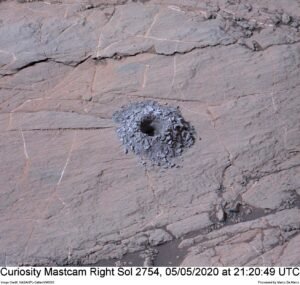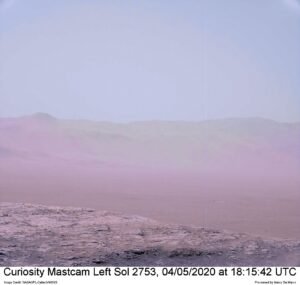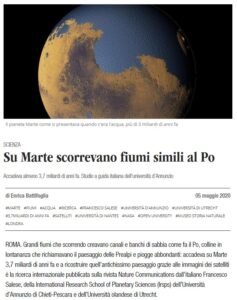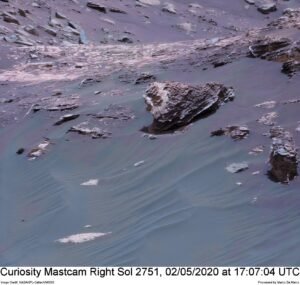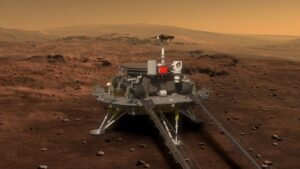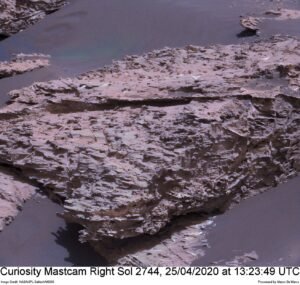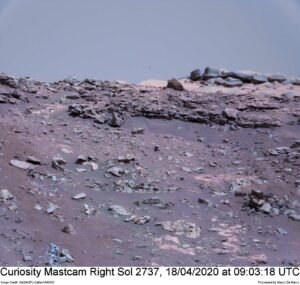Latest Posts
Curiosity Sol 2754, May 5, 2020
At 21:20:49 UTC, Mastcam Right captured the twenty-sixth drill called “Glasgow”.The drilling ended about half an hour before this picture was taken, so I will use it for comparisons with subsequent pictures.As always, part of the excavated material will be analyzed inside the rover, but are also scheduled a whole series of observations and analysis of the material left on the ground, as well as the hole itself (see https://mars.nasa.gov/msl/mission-updates/8667/sols-2756-2757-presenting-our-newest-drill-sample-glasgow/). It will be interesting to observe the evolution over time of the material extracted and the progressive degradation of the hole and the material that surrounds it.The original image has undergone noise reduction due to Jpeg compression, white balance and a slight increase in microcontrast and chromatic saturation in order to make the colors more similar to what the human eye would see.Original image: https://mars.nasa.gov/msl-raw-images/msss/02754/mcam/2754MR0144390011201418E01_DXXX.jpg This post has been automatically translated. See the original post here.
Curiosity Sol 2753, May 4, 2020
At 18:15:42 UTC the Mastcam Left again imaged the inner rim of the Gale crater as in the previous photo from about a month and a half ago (see https://www.facebook.com/PianetaMarte.MdM/photos/a.1625578140858706/2801827566567085/). Comparison with the previous image shows likely dust clouds, or perhaps dust devils, visible as reddish “wads” in areas previously green in color. There are also noticeable changes in hue in the green areas, with noticeable yellowing.Definitely interesting to be able to observe all these changes!The original image is a black and white encoding of the Bayer mask that has been converted to color through a process called “debayering” or “demosaicing”. In addition, the photo has undergone noise reduction due to Jpeg compression, white balance and a slight increase in microcontrast and color saturation in order to make the colors more similar to what the human eye would see. Original image: https://mars.nasa.gov/msl-raw-images/msss/02753/mcam/2753ML0144280000905424C00_DXXX.jpg This post has been automatically translated. See the original post here.
On Mars there were rivers similar to the Po (by Enrica Battifoglia)
It happened at least 3.7 billion years ago, according to an Italian-led study of D’Annunzio University.Large rivers that flowed creating channels and sandbars as does the Po, hills in the distance that recalled the landscape of the Prealps and heavy rains: it happened on Mars 3.7 billion years ago and to reconstruct that ancient landscape thanks to satellite images is the international research published in the journal Nature Communications by Italian Francesco Salese, of the International Research School of Planetary Sciences (Irsps), the University of Chieti-Pescara and the Dutch University of Utrecht. Full article in Italian: https://www.ilcentro.it/attualit%C3%A0/su-marte-scorrevano-fiumi-simili-al-po-1.2412179 Article and video University of Utrecht: https://www.uu.nl/en/research/department-of-physical-geography/water-rivers-and-deltas-on-planet-mars Full research paper in PDF downloadable repeatedly:“Sustained fluvial deposition recorded in Mars’ Noachian stratigraphic record”. https://www.nature.com/articles/s41467-020-15622-0.pdf This post has been automatically translated. See the original post here.
Mars, India approves Dass patent to use planet’s resources
The technology patented by the Aerospace District of Sardinia will make it possible to obtain oxygen, fertilizers, propellants and edible biomass from resources on the red planet.India has approved the granting of a patent owned by DASS, the Aerospace District of Sardinia, on the process to ensure the sustenance of human missions using only the resources available on Mars, from soil to carbon dioxide. So far the technology had been approved by China, Europe, Japan, Russia and the United States of America. The goal of future Dass missions will be to obtain oxygen, fertilizers, propellants and edible biomass from resources on the red planet. This post has been automatically translated. See the original post here.
Curiosity Sol 2751, May 2, 2020
At 17:07:04 UTC the Right Mastcam captured a nice set of layered rocks.Again, we can see small flows coming from the rock visible in the upper right corner, as well as beautiful shades of different colors in the soil further downstream.During this period, REMS data (see https://cab.inta-csic.es/rems/marsweather.html) indicate that the ground temperature reached +17°C while the air +8°C (Sol 2744).So let’s not be surprised if liquid water comes out of the ground, it’s perfectly normal given the current climate conditions!The original image is a black and white encoding of the Bayer mask that has been converted to color through a process called “debayering” or “demosaicing”. In addition, the photo has undergone noise reduction due to Jpeg compression, white balance and a slight increase in microcontrast and color saturation in order to make the colors more similar to what the human eye would see. Original image: https://mars.nasa.gov/msl-raw-images/msss/02751/mcam/2751MR0144230301201287C00_DXXX.jpg This post has been automatically translated. See the original post here.
Mars requires money: White House budget may require withdrawal from Red Planet
The Trump administration is preparing budgets for next year’s funding for NASA, budgets that would include large cuts in spending on Martian exploration.Many missions still in activity could then be “turned off” or limited for lack of funds. Among these the Mars Odyssey, Mars Reconnaissance Orbiter (MRO), Mars Atmosphere and Volatile Evolution (MAVEN) and also the rover Curiosity.An article to read not only for the scientific implications but also for the geopolitical implications that the current health emergency is causing a bit ‘around the world and consequently also to NASA. Full article: https://www.scientificamerican.com/article/mars-needs-money-white-house-budget-could-prompt-retreat-from-red-planet/ This post has been automatically translated. See the original post here.
China’s first lander to land on Mars will be called “Tianwen”
The first Chinese mission with the intent to study the red planet will leave in July.The arrival is scheduled for February 2021, when the orbiter will begin to study the exact location that will be chosen to send to the ground a lander to a rover equipped with six wheels and powered by solar panels.China could then become the second world power to successfully take a scientific mission to the Martian soil!Let’s keep our fingers crossed… Original article: https://www.universetoday.com/145890/chinas-first-mars-lander-is-going-to-be-called-tianwen/ This post has been automatically translated. See the original post here.
Curiosity Sol 2744, April 25, 2020
At 13:23:49 UTC Mastcam Right imaged a layered rock very rich in interesting details….Between and in the layers you can see details of various shapes and sizes, many with a tubular appearance intertwined and/or branched. The top surface is also anything but smooth, full of outgrowths (encrustations?), fractures, roughness and veins of limestone (or chalk…).What could have encrusted a rock that should otherwise be smooth and blunt like that?The original image is a black and white encoding of the Bayer mask that has been converted to color through a process called “debayering” or “demosaicing”. In addition, the photo has undergone noise reduction due to Jpeg compression, white balance and a slight increase in microcontrast and color saturation in order to make the colors more similar to what the human eye would see. Original image: https://mars.nasa.gov/msl-raw-images/msss/02744/mcam/2744MR0143830541201065C00_DXXX.jpg This post has been automatically translated. See the original post here.
Mars, India approves Dass patent for use of planet’s resources
The technology patented by the Aerospace District of Sardinia will make it possible to obtain oxygen, fertilizers, propellants and edible biomass from resources on the red planet.India has approved the granting of a patent owned by DASS, the Aerospace District of Sardinia, on the process to ensure the sustenance of human missions using only the resources available on Mars, from soil to carbon dioxide. So far the technology had been approved by China, Europe, Japan, Russia and the United States of America. The goal of future Dass missions will be to obtain oxygen, fertilizers, propellants and edible biomass from resources on the red planet. This post has been automatically translated. See the original post here.
Curiosity Sol 2737, April 18, 2020
At 09:03:18 UTC the Mastcam Right photographed a ridge in the direction of Mount Sharp, which peeks out just behind the ridge itself, visible as a whitish strip tending to pale pink.The variety of rocks visible in this photo is truly incredible in shape, level of erosion and color!There are several different shades and hues on the ground as well, really interesting….The original image is a black and white encoding of the Bayer mask that has been converted to color through a process called “debayering” or “demosaicing”. In addition, the photo has undergone noise reduction due to Jpeg compression, white balance and a slight increase in microcontrast and color saturation in order to make the colors more similar to what the human eye would see. Original image: https://mars.nasa.gov/msl-raw-images/msss/02737/mcam/2737MR0143480031200694C00_DXXX.jpg This post has been automatically translated. See the original post here.
